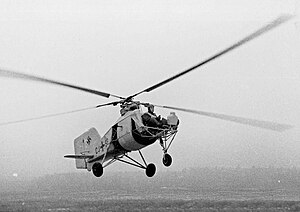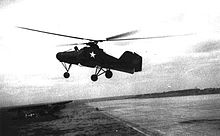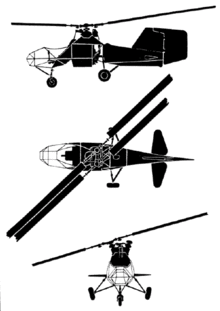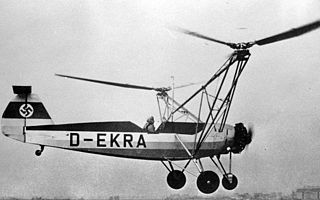
The Focke-Wulf Fw 61 is often considered the first practical, functional helicopter, first flown in 1936. It was also known as the Fa 61, as Focke began a new company—Focke-Achgelis—in 1937.

Anton Flettner, Flugzeugbau GmbH was a German helicopter and autogyro manufacturer during World War II, founded by Anton Flettner.

Anton Flettner was a German aviation engineer and inventor. Born in Eddersheim, Flettner made important contributions to airplane, helicopter, vessel, and automobile designs.

The Focke-Achgelis Fa 223 Drache was a helicopter developed by Germany during World War II. A single 750-kilowatt (1,010 hp) Bramo 323 radial engine powered two three-bladed 11.9-metre (39 ft) rotors mounted on twin booms on either side of the 12.2-metre-long (40 ft) cylindrical fuselage. Although the Fa 223 is noted for being the first helicopter to attain production status, production of the helicopter was hampered by Allied bombing of the factory, and only 20 were built.

Wunderwaffe is a German word meaning "wonder-weapon" and was a term assigned during World War II by Nazi Germany's propaganda ministry to some revolutionary "superweapons". Most of these weapons however remained prototypes, which either never reached the combat theater, or if they did, were too late or in too insignificant numbers to have a military effect. The V-weapons, which were developed earlier and saw considerable deployment, especially against London and Antwerp, trace back to the same pool of highly inventive armament concepts. In the German language, the term Wunderwaffe generally refers to a universal solution which solves all problems related to a particular issue, mostly used ironically for its illusionary nature.

The Kaman HH-43 Huskie is a helicopter developed and produced by the American rotorcraft manufacturer Kaman Aircraft. It is perhaps most distinctive for its use of twin intermeshing rotors, having been largely designed by the German aeronautical engineer Anton Flettner.
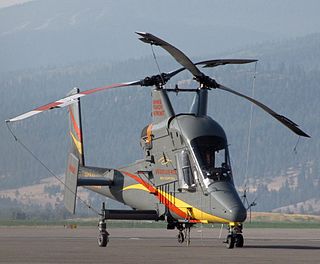
An intermeshing-rotor helicopter is a helicopter with a set of two main rotors turning in opposite directions, with each rotor mast mounted with a slight angle to the other, in a transversely symmetrical manner, so that the blades intermesh without colliding. The arrangement allows the helicopter to function without a tail rotor, which saves power. However, neither rotor lifts directly vertically, which reduces efficiency per each rotor.

The Kaman K-MAX is a helicopter with intermeshing rotors (synchropter) designed and produced by the American manufacturer Kaman Aircraft.

The Flettner Fl 265 was an experimental helicopter designed by Anton Flettner.

The Flettner Fl 185 was an experimental German gyrodyne developed by Anton Flettner, a machine which could fly both as a helicopter and as a gyroplane.
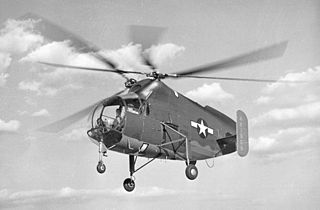
The Kellett XR-8 was a helicopter built in the United States during World War II. It was a two-seat machine intended to demonstrate the feasibility of a twin-rotor system and, while it accomplished this, it also demonstrated a number of problems that prevented further development of this particular design.
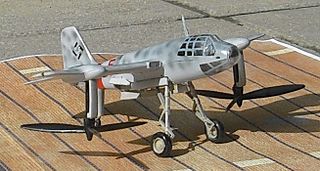
The Focke-Achgelis Fa 269 was a tiltrotor VTOL aircraft project designed by Henrich Focke.
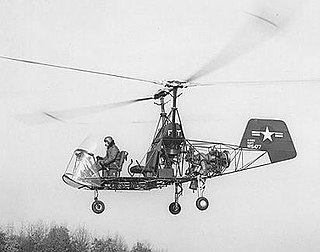
The Kaman K-225 is an American experimental helicopter developed by Kaman Aircraft. One example was modified to become the world's first gas turbine-powered helicopter.

The Doblhoff/WNF 342 was an early experimental tip jet helicopter designed and produced by Wiener-Neustädter Flugzeugwerke. It was the first helicopter to take off and land using tip jets to drive the rotor.

The McDonnell XHJH Whirlaway, aka McDonnell Model 37, was a 1940s American experimental transverse-rotor helicopter designed and built by McDonnell Aircraft Corporation for the United States Navy and was the largest helicopter at the time, as well as the first successful twin-engined twin-rotor helicopter in the world.

The Borgward BFK-1 Kolibri, or Borgward-Focke BFK-1 Kolibri, was a German three-seated utility helicopter built by Borgward, designed by Heinrich Focke and was the first German helicopter after World War II. The helicopter first flew on 8 July 1958 in Bremen, piloted by Ewald Rohlfs.
The Focke-Achgelis Fa 284 was a project to develop a large transport helicopter, designed in 1943 by Focke-Achgelis for use by the Luftwaffe. The helicopter was powered by two BMW 801 radial engines, driving transversely-mounted rotors, and was equipped with a large, detachable cargo pod for carrying loads.

The SNCAC NC.2001 Abeille was a single engine, twin intermeshing rotor helicopter designed and built in France in the late 1940s. Three were completed but only one flew, development ending when SNCAC was closed.
